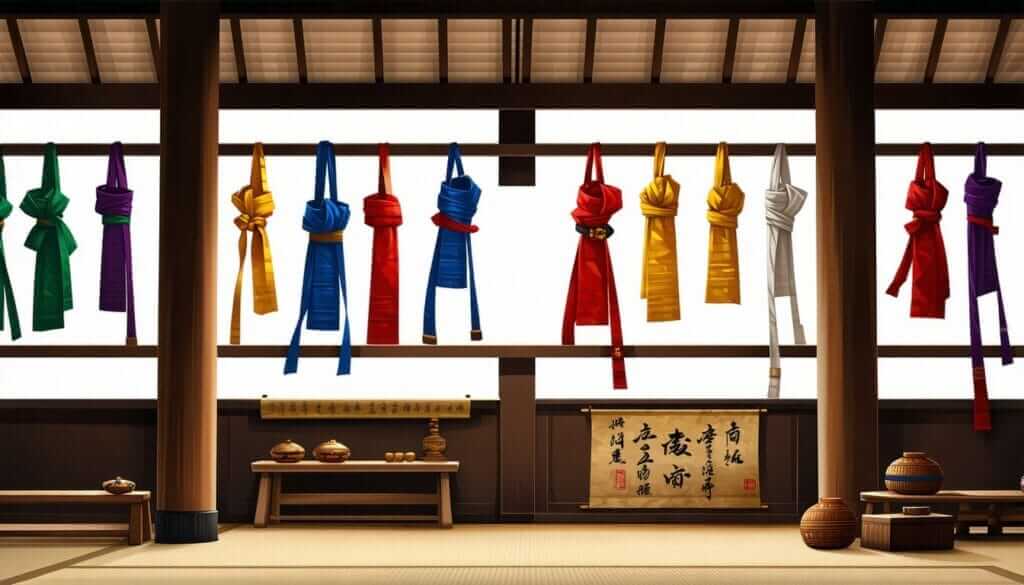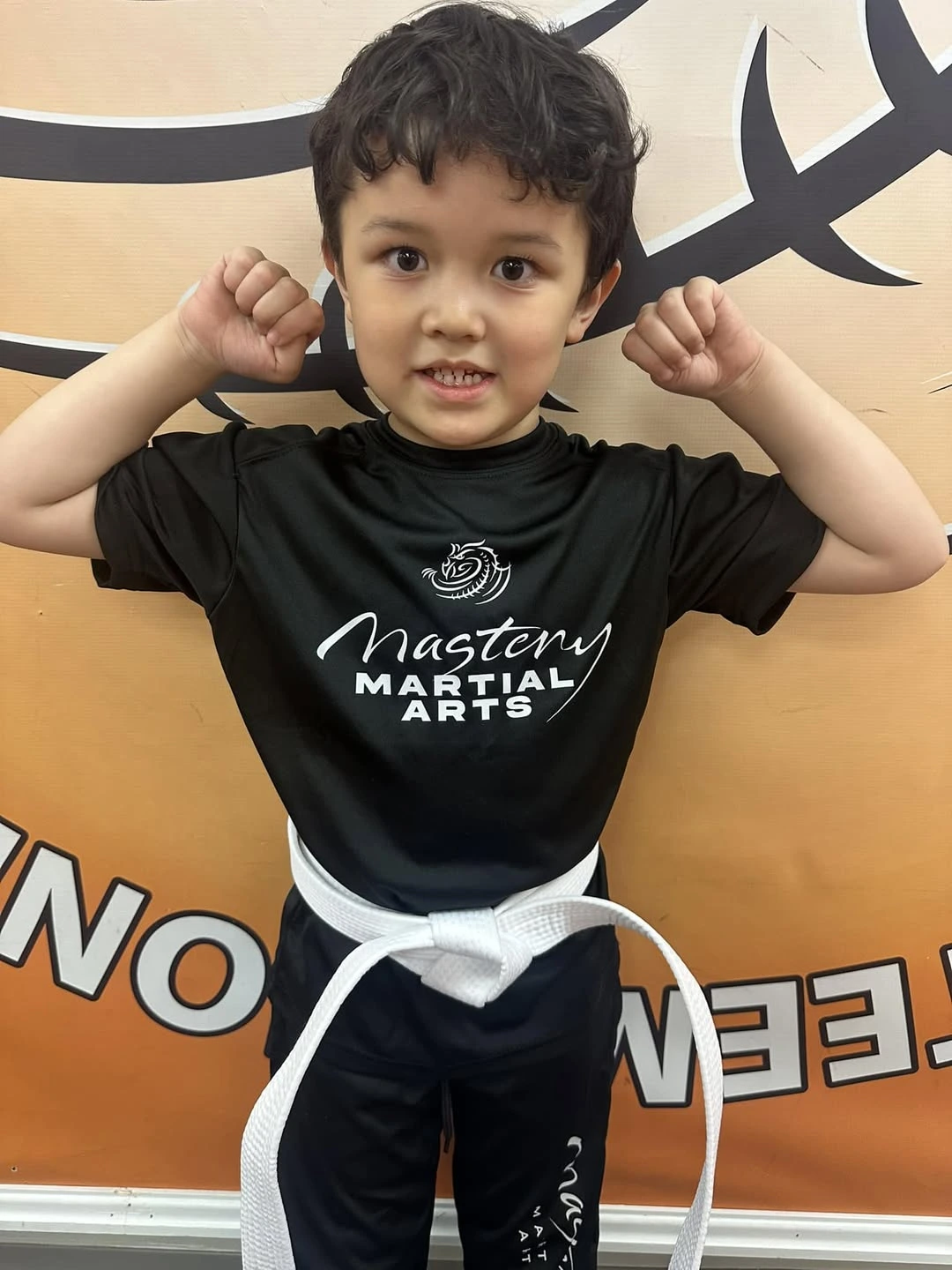Evolution of Belt Ranks
Martial arts belt ranks have come a long way, finding a sweet spot between tradition and the need to keep things functional and relevant for today’s fighters. It’s about respecting where it all started while using what works best today.
IMMAF Grading System
Kickstarted in 2012, the International Mixed Martial Arts Federation (IMMAF) took a keen interest in setting up a grading game plan for mixed martial arts. Picture this as a playbook similar to old-school martial arts. We’re talking about moving from a basic, bright white belt to the epic black one, with every step smacking of skill development and smart strategy understanding—you know, the stuff that warriors are made of.
Here’s how the IMMAF keeps tabs on your progress:
- Checks if you’re using your body right and nailing those techniques.
- Throws you into drills that mimic real-deal sparring situations, especially for those climbing the ranks.
- Tests how much you know off the mat, ’cause knowledge is power!
| Belt Rank | Requirements |
|---|---|
| White Belt | Getting your feet wet with the basics |
| Blue Belt | Nail those foundational techniques |
| Purple Belt | Got the hang of it? Prove those mid-level moves! |
| Brown Belt | Advance into sparring with serious firepower |
| Black Belt | All that and more, plus lead the squad! |
Traditional Belt System Origins
Belt systems got their groove from arts such as Judo, thanks to innovators like Jigoro Kano who lit the fire in Japan back in the early 1900s. Belts became more than just fabric—they’re the ultimate sign of where you’re at. Started with nothing…now they color-code progress!
Why belts rock the dojo and training grounds:
- They’re a quick nod to who’s got the skills.
- They push you to keep pushing.
- They cement respect and order in the dojang or dojo.
Sink your teeth into old-school tales of karate and taekwondo belt ranks on our page about belt ranks in karate history and belt ranks in taekwondo history. These tales pull together the martial arts vibe where cracking advanced techniques means getting respect and demonstrating perseverance. For a comprehensive look at how belts evolved over time, hop to martial arts belt ranking timeline.
Belt Systems in Different Martial Arts
Belt systems in martial arts act like a roadmap, showing where a practitioner is along their journey. Each martial art has its own way of doing things, colored by its history and way of teaching. Let’s take a look at some of the belt systems in different martial arts.
MMA Belt System
Mixed martial Arts (MMA) is the new kid on the block when it comes to martial arts. Many schools don’t stick to a strict belt system. However, the International Mixed Martial Arts Federation (IMMAF), founded in 2012, wants to bring in a system that looks like those of the traditional martial arts. It follows a basic path from white to black belts, but you might see some schools borrowing from Brazilian jiu-jitsu or cooking up their own belt flavors like Gaidojutsu.
| Rank | Belt Color |
|---|---|
| 1 | White |
| 2 | Blue (varies by academy) |
| 3 | Purple (varies by academy) |
| 4 | Brown (varies by academy) |
| 5 | Black |
Muay Thai Belt System
Muay Thai traditionally skips the belt parade. But with its popularity around the globe, some U.S. schools have brought in a ranking system using armbands, known as “praijoud,” to show who knows what. Each color represents a different level of know-how, but not every Muay Thai gym buys into this bandwagon.
| Rank | Armband Color |
|---|---|
| Beginner | White |
| Intermediate | Yellow |
| Advanced | Red |
| Expert | Black |
Karate Belt System
Karate takes its belt system roots from ancient Japanese martial arts and started with just white and black. Over time, new colors slipped in to represent different ranks. The belts are like a badge of progress, skill, and how dedicated a person is to karate.
| Rank | Belt Color |
|---|---|
| 1 | White |
| 2 | Yellow |
| 3 | Blue |
| 4 | Purple |
| 5 | Brown |
| 6 | Black |
Getting from one belt to the next usually involves passing tests that look at both karate skills and knowing karate’s rules.
Taekwondo Belt System
Taekwondo, much like karate, sports a well-laid-out belt system showing off a student’s skills. With roots in Korea, Tae Kwon Do students start their adventure with a white belt and move through the colors until they hit black. Different organizations might do things a bit differently, but the path is usually pretty similar.
| Rank | Belt Color |
|---|---|
| 1 | White |
| 2 | Yellow |
| 3 | Green |
| 4 | Blue |
| 5 | Red |
| 6 | Black |
The stripe of belts in Taekwondo also highlights good behavior and moral character, ensuring folks grow mentally and physically.
These different belt systems show the flavor of philosophies and traditions behind each martial art. Understanding these systems gives you a peek into the bigger picture of martial arts belt ranking philosophy. Want to dive deeper into what all those belt colors mean? Check out our piece on martial arts belt colors meaning.
Symbolism of Belt Colors
Grasping what each belt color means in martial arts? It’s more than just knowing who’s at what level. Each hue tells a story about who’s on the move and who’s getting better at their craft.
Significance of White Belt
Ah, the white belt! Think of it as the blank page. It’s where every newbie starts, diving into the basics of their martial art, from moves to manners. This belt is all about potential and promises—the kind of potential that keeps you coming back to learn more.
While sporting that white belt, it’s all about getting those initial steps right. You’ll focus on the core stuff that sets you up for the cool moves you’ll master later. This color kicks off the martial arts journey no matter what discipline you’re into.
Progression through Colored Belts
As you sharpen those skills, your belt changes color, showing off your journey. Here’s the scoop on what each color traditionally stands for:
| Belt Color | Symbolism |
|---|---|
| White | New beginnings; a clean slate |
| Yellow | Early steps on a promising path |
| Orange | Growth; expanding your horizons |
| Green | Solidified knowledge and commitment |
| Blue | Mastering those trickier moves |
| Purple | Nearing black belt territory; fancy footwork |
| Brown | Skill refinement and maturity |
| Black | Mastery; now the teaching begins |
The whole belt color system? Thank Japan’s Jigoro Kano from the late 1800s, the brains behind Judo. It started with just white and black, but colors got spiced up along the way, marking distinct milestones in the martial artist’s progression.
For students, each belt is a badge of honor, showing off perseverance and practice. Moving through the ranks of colors doesn’t just chart skill ascent—it reflects personal growth, determination, and, yeah, some sweat and grit. Every new belt is more than just flashy gear; it’s a nod to their ongoing journey.
Curious for extra deets on the different belt colors? Peek at martial arts belt colors meaning to uncover more.
Black Belt Achievement
Getting a black belt in martial arts is a big deal, showing off some serious skills and dedication. It’s not just about knowing how to throw a punch; it’s about sticking with it for years, growing, learning, and becoming more disciplined as a person.
Mastery Requirements
Grabbing that black belt means you’re a pro in several areas, like physical skills, mental toughness, understanding techniques, and respecting both the art and your fellow practitioners. It’s not just a walk in the park; you need to put in the hard yards through intense training, pulling off techniques like a boss, and getting sweaty in sparring sessions. On average, reaching this point might take about five years, give or take, depending on the martial art style and how fast you’re picking things up.
| Requirement | Description |
|---|---|
| Physical Skill | Nailing the techniques and forms that are part of the martial art. |
| Mental Discipline | Staying focused, calm, and determined, no matter how tough it gets. |
| Knowledge | Knowing the history, philosophy, and tricks of the trade inside out. |
| Respect | Giving props to your instructors, peers, and the traditions of the art. |
| Dedication | Consistently showing up and being active in the martial arts scene. |
Getting your black belt isn’t just about getting the moves right. It’s about living the core values of the martial art, committing to train, and growing as a person all along the way.
Black Belt Symbolism
The black belt holds its spot as the highest color in the belt hierarchy, marked by various degrees, beginning at first-degree and moving upwards. This climb up the ladder reflects not just expertise but also the martial artist’s dedication and progression through the rainbow of colored belts. It’s like absorbing all the colors of light; once you’ve got your black belt, you’ve pretty much completed one journey, but it also marks the start of another one, often stepping into the shoes of an instructor.
In martial arts, especially in Karate, wearing a black belt suggests you’ve become an expert and are ready to lead and guide others in the dojo. It signifies more than just skill; it’s a badge of personal growth, toughness, and an ongoing thirst for knowledge.
If you’re keen on understanding more about what the different belt colors mean, check out the martial arts belt colors meaning for a deeper dive into the philosophy behind this unique ranking system.
Challenges and Misconceptions
Martial arts belt rankings have been hit with a few bumps and misunderstandings over time. Two main culprits messing with the system are the quickie belt promotions and those sneaky unearned black belts.
Easy Belt Promotions
Lately, you’ve got these so-called “McDojos”—places that act more like a fast food chain than a disciplined school for martial arts. They’re all about raking in the bucks, not molding true martial artists. The result? Students get to flip through belt colors like a deck of cards without actually leveling up their skills or knowledge. It kinda cheapens the whole belt system, making what should be a proud symbol—like a black belt—into something a bit hollow.
Here’s a quick rundown showing what you might find in a genuine martial arts school compared to a “McDojo”:
| Aspect | Real Deal Martial Arts Schools | McDojos |
|---|---|---|
| Promotion Rule | Based on skills and mastery | All about money, easy-peasy standards |
| Training Integrity | High on discipline | Slacking on standards |
| Student Growth | Focuses on long-term development | Fast-track rank jumps |
| Instructor Quality | Skilled and certified | Hit-or-miss, often not up to par |
Unearned Black Belts
Then there’s the issue of unearned black belts floating around. When someone gets handed a black belt without putting in the work, it’s risky not just for them but for everyone involved in martial arts. An unearned black belt might swagger with authority but lack the chops to back it up, leading to risky moves and unsafe antics.
Distinguishing a true black belt from a paper one is vital to keeping the martial arts philosophy pure. A real black belt not only knows their stuff but also walks the talk with discipline and skill. An unearned one? They might just be missing the core abilities that justify the rank.
Grasping the philosophy behind these belt ranks is super important. Dive into the histories of belt ranks in karate and belt ranks in taekwondo to get the lowdown on how these rankings came to be and their deeper meaning.
Instructor Influence and Guidance
In the land of martial arts, instructors are the secret sauce, shaping students’ journeys up that colorful belt ladder. They dish out not just moves, but the whole philosophy and principles that turn punches and kicks into life lessons.
Role in Student Progression
Instructors are like GPS for students, keeping them on track through the belt maze. They check skills, offer tips, and set realistic goals. Their seasoned eye helps students know what it takes to earn that shiny new belt. Picture a Taekwondo class where instructors drill into skill sharpness, discipline, and nailing those techniques that push you to the next level.
| Belt Color | Average Time to Earn | What Instructors Do |
|---|---|---|
| White | Right away | Teach the basics |
| Yellow | 3-6 months | Lay the foundation |
| Green | 6-12 months | Introduce some flair |
| Blue | 1-2 years | Step it up |
| Brown | 2-3 years | Hone and spar |
| Black | 3-5 years | Master and lead |
Mentoring and Support
Beyond just teaching, instructors become mentors. They create a space where students grow, absorbing discipline, respect, and grit. This bond can shape a student’s path, especially since mental toughness is as crucial as the physical stuff in martial arts.
Instructors ensure that belt promotions hold meaning. They’re the gatekeepers, defending against the “McDojos” handing out black belts like candy, which can mess with the art’s credibility. Getting a black belt requires years of sweat and skill, with instructors standing by these standards while resisting commercial shortcuts.
To sum it all up, instructors aren’t just along for the ride; they’re behind the wheel, steering students on their martial arts adventure. Their guidance makes every belt step matter, showing the world what real mastery is about. Curious about how the belt rainbow came to be? Check out our piece on martial arts belt ranking history.




